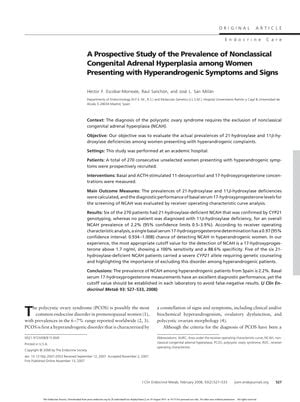A Prospective Study of the Prevalence of Nonclassical Congenital Adrenal Hyperplasia Among Women Presenting with Hyperandrogenic Symptoms and Signs
November 2007
in “
The Journal of Clinical Endocrinology and Metabolism
”

TLDR About 2.2% of women with symptoms of high male hormones have a mild form of congenital adrenal hyperplasia, and measuring a specific hormone level can accurately diagnose it.
In a 2008 study involving 270 Spanish women with hyperandrogenic symptoms, researchers found a 2.2% prevalence of nonclassical congenital adrenal hyperplasia (NCAH) due to 21-hydroxylase deficiency. The study highlighted that basal serum 17-hydroxyprogesterone is an effective diagnostic tool for NCAH, recommending a cutoff value of 1.7 ng/ml for optimal sensitivity (100%) and specificity (88.6%). The study also noted that the clinical and biochemical profiles of women with NCAH were similar to those with polycystic ovary syndrome (PCOS), except for elevated 17-hydroxyprogesterone and 11-deoxycortisol levels. It concluded that a single measurement of basal serum 17-hydroxyprogesterone in the morning during the follicular phase had a 97.1% probability of correctly identifying women with NCAH, suggesting that serum androgen levels are not reliable for screening due to low specificity. The findings underscore the importance of excluding NCAH in hyperandrogenic patients, particularly to identify those who may need genetic counseling due to carrying a severe CYP21 allele.









